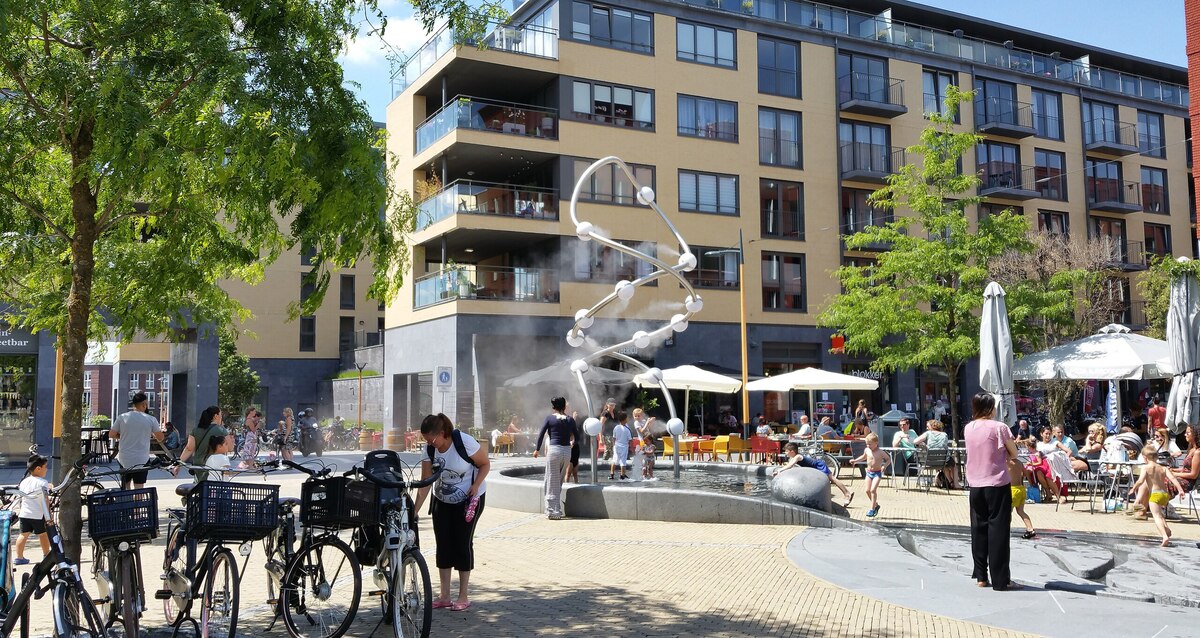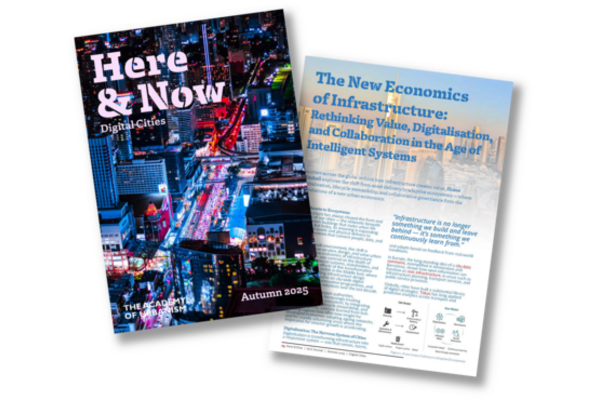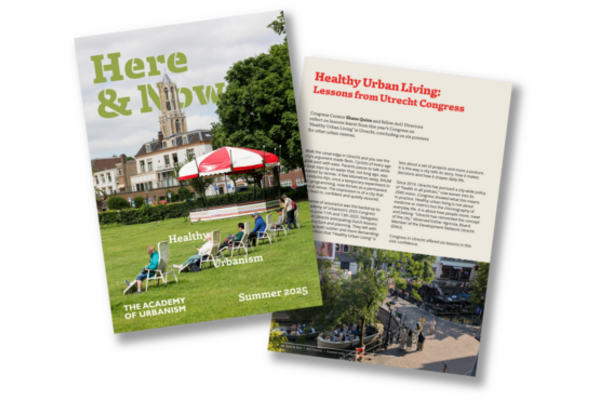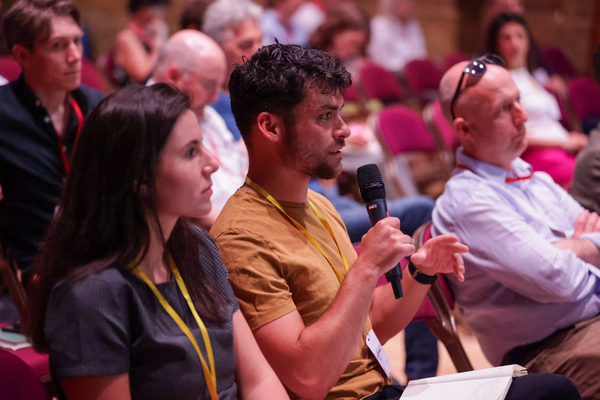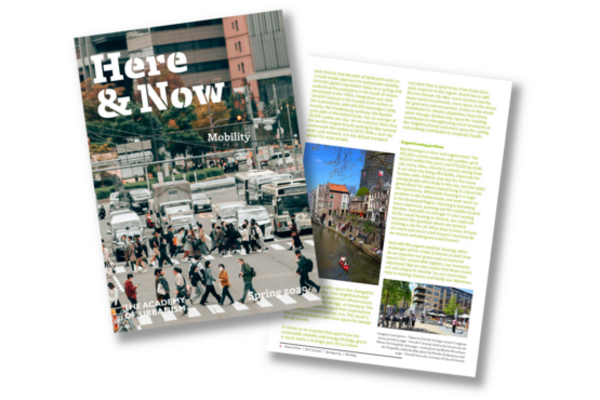This article was originally published in the Spring 2025 edition of the AoU's Here & Now e-journal, themed on Mobility.
Ahead of hosting Congress 2025 in the city, Utrecht’s Bart van der Vossen reflects on the importance of mobility in healthy urban living.
Good urbanism focuses on places. Great urbanism focuses on people. Because cities are about people coming together. They give us the ability to coalesce quickly, collaborate easily, and cohabit closely. It makes this activity easier, improving our individual and collective lives. Our Utrecht vision for 2040, uniquely putting health at the heart of all policies, and its recent placemaking story define Healthy Urban Living. It holds the view that healthy lives make healthy citizens and healthy citizens make healthy cities. Above all, in Utrecht we recognise that urbanism is truly about shaping places that make peoples’ everyday lives easier, happier, and healthier.
Capitalising on our heritage and location, the city is the fastest growing in the Netherlands. Located in the crucial Randstad region, and home to one of Europe’s oldest universities, thousands of Dutch students graduate and choose to stay put with their skills. Biotech, finance, and health multinationals are big employers. Continent-wide transport links mean London, Paris, and Frankfurt are no more than a half-day train journey.
Underpinning Utrecht’s future is ‘Utrecht Nearby: the ten-minute city’, our vision for 2040. Adopted in 2021, this gives voice to our belief that our growth must be shaped around its people and their needs. It identifies that growth depends on how well the city connects mobility, housing, public facilities, energy, greenery, the economy, and jobs. We believe that our future placemaking must address these challenges in ways that reduce gender, race, income, and age disparities if ‘Healthy Urban Living’ is to be about more than mobility or environmentally conscious land use. We are using the principles of a broad and positive approach to health, in which the person is central, equity, and working in partnerships, to guide its ‘Health in all policies’ approach. Perhaps most enlightening is our goal of ‘Grow is not a goal in itself; we grow in balance.’ With all our challenges kept in mind, it gives us a clearer focus on the kind of choices that need to be made.
Utrecht’s Transport Story
Forty years ago, ‘liveability’ was not on Utrecht’s radar. Between 1970 and 1990, the city’s population shrank by 50,000. There was vacancy and dilapidation, with plans to demolish parts of the beautiful Lombok district. It was the era in which we created the highway through our city center. The very one we recently restored in a waterway. There was little attention to the importance of green space. Today, Utrechters want to stay in the city en masse.
The city has one of the world’s busiest cycleways and where a motorway once covered a historic canal, goods are now transported once more by water into the city core and people gather by the water’s edge. The city has the highest percentage of shared cars in the Netherlands due to an active support system. That saves a lot of space, which is really needed in order to create new neighbourhoods within the city boundaries. Data shows that car use and ownership did not increase over the last 5 years, while the number of inhabitants grew by approximately 20,000.
Utrecht has made Healthy Transport a way of life. This theme is a vital component of the Utrecht story and one for which we receive global attention. But this current reality stems from past choices and decades of dedicated work on a multi-modal approach to sustainable mobility. Utrecht’s global reputation today as a cycling and pedestrian-focused place is the result of visions developed in the 1990s. Integration was vital. Utrecht Centraal is the busiest train station in the Netherlands, with 200,000 passengers daily. Nearby, the Vredenburg cycleway, the busiest cycle path in the Netherlands, has an average of 33,000 cyclists per day. It’s no surprise, then, that the world’s largest bicycle parking facility opened underneath the station in 2019. With a vast city-wide cycle network, it is the default transport option for most people.
Designing the city’s public space has changed to help deliver this reality. New neighbourhoods incorporate cycle and pedestrian infrastructure, like the Dafne Schippersbridge, as standard. The city’s residents have changed their expectations for healthy transport options, too. The result is less vehicle pollution and more space for people on city streets.
It comes as no surprise that apart from the sustainable mobility and energy strategy, green is much more a strategic part of our future narrative than it used to be. From front door, park, to green in the region. And it ties in with the ten-minute city idea: more services nearby, fewer travel movements, more space in the street for greenery and encounters. Green in the street contributes to climate adaptation, heat stress, water storage, biodiversity; space for meeting contributes to strengthening social structures in the neighbourhood; and more space for cycling and walking contributes to residents’ health.
Urgent housing problem
But housing is a clear and urgent need. The 375,000 current residents will number up to 400,000 within five years and 470,000 by 2040. Like many cities, Utrecht is actively asking how it can keep city living affordable, especially for families with children, but also for the many young people who study in the city, and the older generations for whom mixed living is a boon for life expectancy. Affordable housing is a huge problem in the Netherlands and even more so in the Randstad Region. Housing is becoming more expensive, pushing out the middle-income families. And with an average 11-year waiting list for social housing in Utrecht, we could ask ourselves the question where we stand in creating a city for all. What does it mean if there are more and more small houses? And how do we ensure well-designed small homes?
And with the urgent need for housing, other challenges will be under pressure as well; how do we organise our green and recreational space? Our sustainable logistics, our economic expansion? But we also realise that those issues are not unique to Utrecht. So, our vision does help in making choices and clarify our dilemmas.
The Utrecht Barcode
Part of our vision for 2040 is that Utrecht sees a home as only the start. It knows that people need local schools and jobs, places to exercise and enjoy nature, to experience cultural activity and use their skills, and to generate clean energy. People - cities - need neighbourhoods. Creative tools like the ‘Utrecht Barcode’ illustrate how we intend to organise urban space. This barcode was designed a few years ago to specify the extra infrastructure and amenities for neighbourhoods beyond mere housing need. New urban centres are planned where transport connections already intersect or on former industrial land to maximise connection, liveability, and environmental sustainability. Innovation is crucial to properly tackle challenges such as grid congestion and climate adaptation. Moreover, history shows that a one-sided focus on construction speed, as in post-war neighbourhoods, can lead to higher social costs, such as healthcare costs. That is why we opt for speed with quality and quality of life for current and future generations, for which municipalities need room to manoeuvre and flexibility to accelerate with customised solutions.
Liveability is the radar for this focus. 81% of Utrecht residents report being happy. 86% are satisfied with their lives. Crucially, 74% feel healthy. Social cohesion in the city is stable, and most Utrecht residents feel at home in their neighbourhood and have trust in their fellow citizens. But challenges remain, as in many other cities. Still, there is recognition of increasing challenges around life inequities, loneliness, and integration. These challenges are familiar to cities around the world and to us urbanists who work in them.

One example regularly cited is the 13-year life expectancy gap for people living in Overvecht compared with Noordoost, two neighbourhoods separated only by a railway line. The ability to make ends meet translates into large differences: among more affluent Utrechters, 88% generally feel happy and 80% feel healthy, whereas, among those who are battling, this is 52% and 54% respectively. Isolation is a concern: one in five Utrecht residents feel discriminated against, and 15% of people - rising to 1-in-5 young Utrechters - feel extremely lonely. Loneliness and growing inequality are essentially the two biggest health challenges for the future.
Are we able to implement every ambition that we formulated? That’s another discussion. But making health central to every single policy decision was crucial. It demonstrates that the city’s placemaking of the last 35 years has not only made it a more physically attractive place but was also designed to make human connections easier. Our 2040 vision outlines that sufficient quality of life through having access to good education, a place to live, job opportunities, meaningful daytime activities, and decent care are only the beginnings of a healthy society. It is explicit that life is not just about material things; people also want to be seen, and a basic sense of interconnectedness is essential for wellbeing in a city. Good urbanism focuses on places. Great urbanism focuses on people. Because cities are about people coming together. Utrecht has many stories to share about how to put people in the core focus to create a healthy city. And lots of challenges that remain to be solved.
Bart van der Vossen is Director of Urban Development at the municipality of Utrecht. Before that, he worked as an architect and urban planner for over 25 years.
The Academy’s Congress will take place in Utrecht 11 - 13 June 2025 on the theme of Healthy Urban Living. The programme, tickets, and more info are available at theaou.org/utrecht




